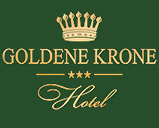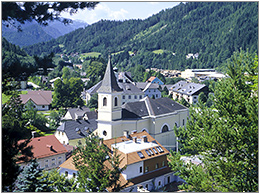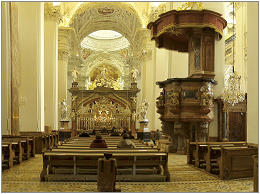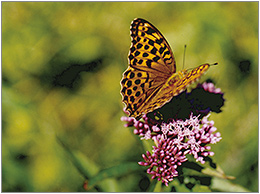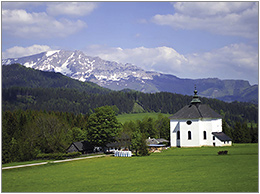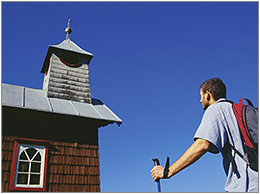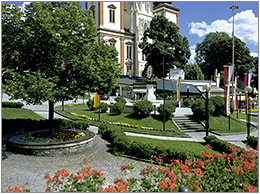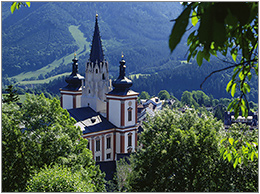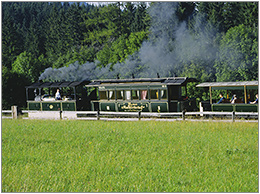
History of Mariazell
Location
Mariazell is located between the borders of Styria and the Northern Austria regions, in the Northern Limestone Alps, in the bottom of Bürgeralpe (1270m). The town is situated in the middle of several valleys’ meeting point; which can only be left crossing smaller and bigger passes. The neighboring valleys spread radially: Salzatal, Walstertal, Ürünautal, Aschbachtal, Gollradtal, and also Erlauftal, Lassingtal which are located in Niederösterreich.
Climate
The region from the climate point of view is not one of the favored parts of Austria. The winters are colder than the average, in Halltal, which belongs to this region; -30 °C is not scarce. The summers are also milder than the average, heavy rains are typical. The friendliest season is the fall, the sunniest days appear in October, and November is the driest month. Yearly moisture is 1200 mm, the wettest month is July and December, because of the latter one, this region can be called snow-proof, and it has snow-blanket 115 days a year. Beside it, this climate favors the forming of fogs, mostly in the valleys. Mariazell is under fog 60 days a year. Dominant direction of wind is Northwestern, but it often blows from the direction of the Southeast from Hochschwab. In the valleys temperature inversion is typical.
History
There is not any proof that there was any ancient settlement from Anno Domini or the First Century, but the Illyr and Celtic names of the region’s mountains and rivers tell differently. They probably knew the existence of the halltal salt, and the 16th century A.D Roman salt roads went through this land.
In the 6th century, during the rule of the Avars, Slavic farmers settled down in the neighboring mountains, this could be seen from the place and mountain names. In 1025, Emperor Conrad XI gave nowadays Mariazell’s territory and some parts of the Mürztal earldom to his sister-in-law Beatrix as a gift. The argument around the present went all the way to the Pope, but the decision was made by Eberhard, the archbishop of Salzburg, who gave the territory to the St. Lambrecht abbey. The day when the town was established is due to a charter from Pope Adrian IV from 21st of December 1151.
The name Cell appeared in the charter of Fritz II, where he assures free disposal over the Cell region’s salt and ore incomings for the abbot of St. Lambrecht. After that the abbot had gotten permission in 1342 for holding a fair. For this he had chosen the than quite important settlement, Mariazell. In 1344, the settlement had gotten the right for holding fairs, which let citizens to trade and hold fairs. The nowadays main square and the three main streets were formed this time, and these places still look the same. In the 14th century the church has been rebuilt several times in gothic style. The first time the Turks came was in 1420, and fires damaged many houses and the church. In 1474 another fire made more damage. In 1532 the Turks returned and they burnt down many houses, but they did not ruin the church.
In 1644, the reconstruction of the church, which made it baroque style, had started and the work ended in 1780. In 1679, Emperor Leopold I went to Mariazell, but one member of his accompaniment brought the plague to the town, which had 156 victims. In 1683 because of the fear over another Turkish attack, the grace statue and the Maria picture was transported to St. Lambrecht, but later they had put it back to its original places.
In 1736 the newly wed Maria Theresa and her husband went to Mariazell, and she gave ore exploitation right to the abbot in the Arshbach and Gollrad territory, furthermore she authorized the building and the operation of a steel factory. In 1786, Emperor Joseph II dissolved many monasteries. He dissolved the Lambrecht monastery, which affected Manazeli. They hampered the pilgrimages and later on they dissolved them all. In 1798 another huge conflagration made a lot of damage in the settlement.
In 1800, another fire devastates in other parts of the town, and in 1805 when the French attacked, there are fights in the surrounding of Mariazell. In 1809 parochial treasures are transported to Timisoara, fearing from the French, who than conquered the settlement. The fights, the lootings and the bad crops decimated the population. In 1816, famine took place in Mariazell, for that prince Leopold sends potato supplies to help. The biggest fire what the settlement’s history had ever seen, took place in 1827, and it almost demolished the whole town, the church also damaged badly. Although during 1828 and 1832 it was rebuilt it had huge sacrifices. In 1837 Emperor Ferdinand I. went to Mariazell. For the 700th anniversary emperor Franz Joseph I. with his wife, Elisabeth also went to town for the celebration. During his reign they establish the first gendarmerie, they elect the first mayor, they build the first look out tower on the Bürgeralpe and they establish the first Firehouse. The electricity works finishes in 1892, which provides electricity for Mariazell, in 1896 they build the first general water pipe, and in 1898 they close the steel factory down. In 1907 the rail line goes from Kirchberg to Mariazell, and they celebrate the 750th anniversary of the town existence. In 1908 the church’s rank is promoted to basilica, and this is the very first year, when Matthias Zdarsky holds the first ski trainings. In 1910 for the third and last time Emperor Franz Joseph went to Mariazell. In 1911 the last emperor, at the time Prince Charles and his wife Zita went to Mariazell. In 1928 one of the first cabin cable railways was built on the Bürgeralpe.
In 1945 the Russians went into Mariazell, with 5000 people. In 1948 the settlement gets the town rank. In 1966 Mariazell went under the authority of the Kremsmunsten abbey, and in the following few years the parochial buildings had many significant reconstructions. In 1983, Pope John Paul II went to the town, and the altar stood in the main square. Because of this occasion the whole town had much reconstruction work.
In 1991, Cardinal Joseph Mindszenty’s mortal remains were transported to Esztergom, Hungary. In 1992, Mariazell goes back to the authority of the founder, the St. Lambrecht abbey. Pope Benedict XVI went to Mariazell on the 8th of September 2007 because of the 850th anniversary of the town’s existence.
The origin of the name, legends
The town’s name
On the 21st of December 1157 a monk of the St. Benedict order, called Magnus, came to the surroundings. The abbot of St. Lambrecht sent him there, to be the pastor of the people who live nearby. Magnus brought his wooden Mary statue with him. On the way there, the road was blocked by a huge stone, which he could not cross. The monk prayed to the Holy Mother and the prayers found her ears because the stone had broken, so he could continue his mission. When he arrived, he put the statue on a snag and built a little wooden chapel around it (“Maria in der Zette”), which little chapel became the center of the spiritual life for the surroundings.
The Henrik legend
The Moravian margrave, Henrik and his wife had so heavy gout that they could not even get up from their bed. One night St. Wenzel told them to trust the Holy Mother and after they get well, they have to do a pilgrimage to Mariazell, where they should thank the Holy Mother by building a church. After they did what they were supposed to, they went back home. Probably Henrik (1197-1222) was the brother of King Ottokar I.
The Louis legend
Against King Louis I of Hungary’s army, which had only 2000 members, the Turks and other Barbarian tribes went with an army of 8000 members. Seeing that his chances of winning the battle were really low, he prayed to Zelli Godmother, who told him in a dream, that her support is with him. When he had woken up, he found his Mary picture, what he kept on an altar, on his chest. He went to the battle, thinking that this was a heavenly sign and his army won this huge battle. For his gratitude, he went to Mariazell with his army, where he donated his picture to the church along with many other gifts. This legend depends on historical facts. King Louis I of Hungary reigned from 1342 to 1382. The battle’s date is uncertain; historians believe that it was in 1364.
Economy
Mariazell belongs to the Bruck an der Mur region in Styria. In this region industry used to be the dominant factor, but just like with the other parts of the country, focus shifted to the third sector. While in the first and second sector the number of employments is decreasing, in the services and tourism area, it is increasing almost with the same degree. The region’s two bigger cities (Bruck an der Mur, Kapfenberg) provide 70% of the workplaces and behind them by 5% comes Mariazell. Mariazell’s most income comes from tourism, approximately every fourth workplace is either a restaurant or bar or a hotel. The region’s economical stats (income, employment, unemployment) just slightly differ from the countries average. The town has many small enterprises, which have traditional goods, and they make things for personal use. Probably most famous of all is the liquor museum, where they make the liquor from a traditional formula, which contains herbs. The other one is the gingerbread factory, where they also make the famous Mariazell gingerbread from an old recipe. Both of these factories can be attended.
Pilgrimage place
The town is one of Middle Europe’s most well known Mary-shrines; the pilgrims come here for centuries believing that the Holy Mother will help them. They call the Holy Mother on many names: Magna Mater Ausiriae, Alma Mater Austriae, Gnadenmutter von Mariazeli, Alma Mater Gentium Slavorum, Magna Domino Hungarorum. The basilica’s two most important treasures are one statue about Mary and the Baby Jesus and the Virgin Mary picture what King Louis I gave to the church. The statue is 48 cm high, it is wooden and it shows Mary who holds Baby Jesus in his right hand, with her left she offers a pear to the baby, and the baby offers an apple to his mother with his right hand. The statue is dressed up three times a year, on the most important celebrations: on Native Friday, Mary’s date of birth (8th of September), and the day the town was established (21st of December). These clothes, which are made from expensive materials and lace, were made and given by noble women. These clothes were mostly made in the 20th century. The Madonna’s and the Baby Jesus’ crowns are also gifts, mostly Sándor Rudnay Prince-primate gave them in 1821 and on the statue are a pair of crowns which were blessed by Pope Pius X. in 1908.
Pilgrims arrived in Mariazell from the 12th century, but their number increased from 1330. The popularity of the place increased until the order from Joseph II, which banned pilgrimage. After the end of prohibition it still rises, until nowadays, when approximately 1 million people come per year. According to some statistics every 6th come by feet. The traditional pilgrimage routes, which are approximately 1100 km long, were summarized in the name of “Mariazell pilgrimage routes”. These routes go from Vienna, Burgenland, Northern Austria, Styria, Southern Austria and Carinthia to Mariazell.
Sights
- Basilica: the church with the typical three towers is the symbol of the town. It specially mixes the gothic and baroque styles; Fischer von Erlach made its altar.
- Rock of Magnus (Ursprungsfelsea): according to the legend, this was the stone, which blocked the monk’s road, but because of his prayers, it had broken. Some say that this is why the town came to existence. A tourist trail goes to the rock.
- Miner Museum in Gußwerk: an exhibition can be seen about the neighborhoods mining industry in the once was steel foundry’s building.
- Museum tram (Museumstramway): the world’s oldest steam train can be seen in Mariazell’s railway station. These trains are reconstructed and they have a 19th century mood when people travel around for a short while.
- Mariazell train: this narrow track small train offers a romantic travel alternate between Sankt Pölten and Mariazell.
- Bürgeralpe: to Mariazell’s 1267 meter high mountain anyone can go up by feet or by cabin elevators. Besides the amazing view, the mountain has many ski slopes, a look out tower, an adventure park and many intimate alpine huts that all wait for the visitors.
- Holzknectland Adventure Park: this adventure park, which is on the Bürgeralpe, demonstrates the lumberjack’s life.
- Gemeindealpe: the highest point of the Mariazell region can be found in Northern Austria. To this 1626 meter high mountain, elevators go up. At the top of the mountain, amazing view awaits the visitors. It is a popular ski region in wintertime.
- Salza: this 88 km long river is popular around the wild water hikers
- Holy well (Heiliger Brunnen): they say that the well’s water heals, so the pilgrims often take home with them.
- Mechanical Bethlehem: this unique Bethlehem shows 12 New Testament scenes with more than 130 moving figures, and it can be found on the Kalvaria Mountain in a private house.
Twin cities
Mariazell gained entrance in 1st of May 2004 to the European Sanctuary Organization, which was established in 1996 and has the following Mary-shrines as its members:
- Fatima, Portugal
- Lourdes, France
- Loreto, Italy
- Czestochowa, Poland
- Altötting, Germany
- Mariazell, Austria
- Twin city: Esztergom, Hungary (6th May 2002)
Hotel, Restaurant, Cafe Goldene Krone A-8630 Mariazell, Grazerstraße 1. Tel. +43 3882 2583 Fax +43 3882 2583 33 EMAIL: krone@mariazell.at
